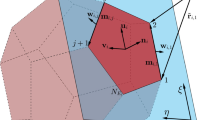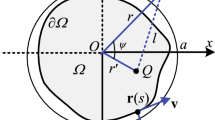Summary
The approach described in this paper allows the numerical calculation of the gravity of two- and three-dimensional bodies, provided their boundaries can be expressed by two single valued functions. Boundary integral theorems are used to convert the integrals for the gravity components into a form which can be integrated numerically. To perform numerical integration routines based on the Gauβ quadrature method are applied.
Zusammenfassung
Es wird ein Verfahren beschrieben, das die numerische Berechnung der Schwere von Modellkörpern ermöglicht, falls deren Oberfläche durch eindeutige Funktionen darstellbar ist. Die Integrale für die Schwerekomponenten werden durch partielle Integration in eine numerisch integrierbare Form gebracht. Die numerische Integration erfolgt nach der Gaußschen Quadraturmethode.
Similar content being viewed by others
References
Bhattacharyya, B. K., Chan, K. C.: Computation of Gravity and Magnetic Anomalies due to Inhomogenous Distribution of Magnetization and Density in a Localized Region. Geophysics42, 602–609 (1977).
Bhattacharyya, B. K.: Computer Modeling in Gravity and Magnetic Interpretation. Geophysics43, 912–929 (1978).
Frese v., R. R. B., Hinze, W. J., Braile, L. W., Luca, A. J.: Spherical-Earth Gravity and Magnetic Anomaly Modeling by Gauss-Legendre Quadrature Integration. J. Geoph. 49, 234–242 (1981).
Götze, H. J.: Ein numerisches Verfahren zur Berechnung der gravimetrischen Feldgrößen dreidimensionaler Modellkörper. Arch. Met. Geoph. Biokl., Ser. A27, 195–215 (1978).
Jeffreys, H., Jeffreys, B. S.: Methods of Mathematical Physics. 3rd ed. Cambridge: University Press 1956.
Jung, K.: Schwerkraftverfahren in der angewandten Geophysik. Leipzig: Geest & Portig 1961.
Ku, C. C.: A Direct Computation of Gravity and Magnetic Anomalies Caused by Two- and Three-dimensional Bodies of Arbitrary Shape and Arbitrary Magnetic Polarization by Equivalent Point Method and a Simplified Cubic Spline. Geophysics 42, 610–622 (1977).
Okabe, M.: Analytical Expressions for Gravity due to Homogeneous Revolutional Compartments in the Gaussian Divergence Approach. Geoph. Prosp.30, 166–187 (1982).
Patterson, T. N. L.: The Optimum Addition of Points to Quadrature Formulae. Math. Comp.22, 847–856 (1968).
Patterson, T. N. L.: On Some Gauss and Lobatto Based Integration Formulae. Math. Comp. 22, 877–881 (1968).
Talwani, M., Worzel, J. L., Landisman, M.: Rapid Gravity Computations for Two-Dimensional Bodies with Application to the Mendocino Submarine Fracture Zones. J. Geoph. Res. 64, 49–59 (1959).
Author information
Authors and Affiliations
Additional information
With 2 Figures
Rights and permissions
About this article
Cite this article
Granser, H. Gravity effect calculation of two- and three-dimensional bodies by numerical integration. Arch. Met. Geoph. Biocl. A. 33, 229–238 (1984). https://doi.org/10.1007/BF02257727
Received:
Issue Date:
DOI: https://doi.org/10.1007/BF02257727




